Summary
Preventing traditional summer pinkeye in cattle involves eliminating the many eye irritations listed in this report. Identifying and taking steps to resolve physical hazards in your operation, including face fly control, may be more effective than pinkeye vaccinations. Offer protection from the sunlight by providing adequately sized shade and allow cattle to graze at night when face flies are not active. Make sure mineral consumption is adequate months before the pinkeye season. Selenium, copper, and zinc are vital for maintaining eye health. Be vigilant and immediately isolate the first case of pinkeye. Seek a veterinary diagnosis. Develop a treatment and prevention plan with input from your veterinarian.
What is pinkeye?
The scientific name for pinkeye is infectious bovine keratoconjunctivitis (IBK). It is a disease of cornea (eye surface) and the conjunctiva (eyelids). IBK is reported as the most common cause of eye disease in all breeding females and calves more than three weeks old. It is second only to calf scours, the most prevalent condition affecting pre-weaned calves (Dewell).
The first clinical signs of any eye irritation, including IBK, is often tearing, tear staining, and eyelid squinting. Tearing often increases as the pinkeye progresses. IBK may suddenly appear as an opaque spot on the cornea, making early recognition difficult. Conjunctivitis is sometimes seen but not in every case. Corneal ulceration may occur as pinkeye progresses.
Some cases of IBK spontaneously resolve. Others result in severe damage to the cornea and blindness. IBK is costly and labor intense to treat. Suffering cattle have decreased appetite because of pain or decreased vision and the inability to locate food and water. Cattle with scarred or ‘blue’ eyes with prolapsed corneas, or blind cattle have reduced value at the market.
Associated pinkeye factors
Normal eyes have adequate defense mechanisms to prevent infection and subsequent corneal ulceration. Any form of eye irritation allows pathogens to penetrate the cornea:
- Physical trauma from aggression between animals, overcrowded bunks, self-feeders; handling during transport; abrasive bedding, grazing close to field margins where thorns, barbed wire and tufts of dry stalks of grass can scratch the cornea; rust/corrosion and the sharp edges from galvanized handling systems and penning; tail switching especially when crowded together under shade
- Blowing dust and sand, weed seeds/chaff
- Face flies
- UV irradiation (bright sunlight) causes cell damage to the conjunctiva and cornea
- Chemical trauma, i.e. fresh nitrogen on pasture
Other IBK associated factors include stress from shipping, processing, and insects which can all be immunosuppressive. Younger cattle are more susceptible to IBK than are older cattle. Cattle with white faces,except Brahman cattle, appear to have a higher incidence of IBK. Mineral deficiencies involving selenium, copper and zinc have been diagnosed in recurrent IBK herd outbreaks.
Microbial agents involved with pinkeye
The eye has a limited number of ways to respond to disease or injury; clinical signs look the same for a variety of reasons. Since the 1970’s, Moraxilla bovis is accepted as the most common cause of traditional IBK (‘summer pinkeye’). M. bovis is a gram-negative rod-shaped bacterium with pili that allows them to attach to eye surface. M. bovis produces a toxin and hemolysin which play roles in pathogenicity. M. bovis can be isolated from normal eyes; asymptomatic carriers reside in herds.
Other Moraxella species were identified as causing IBK, the first being Moraxilla ovis. Moraxilla bovoculi was next characterized in 2007 using polymerase chain reaction (PCR) diagnostics. Since 2007, it has become clear that the vast majority of M. ovis recovered from bovine eyes prior to the ability to identify M. bovoculi would now be reclassified as M. bovoculi.
According to the 2010 Iowa State University study conducted by Connor et al, M. bovoculi could be isolated with or without M. bovis from calves with IBK. Moraxella bovoculi and bovis were more frequently recovered from eyes with IBK lesions than unaffected eyes.
M. bovoculi is often associated with ‘winter pinkeye’. Winter pinkeye is present year-round and occurs in stabled cattle. It does not appear to need physical trauma, or summer flies and UV light often associated with traditional ‘summer pinkeye’. Carrier animals may exist in the herd, with M. bovoculi residing in eyes, nasal passages, and vaginal tissues.
Other bacteria isolated from IBK include Mycoplasma and other respiratory pathogens and Listeria monocytogenes (associated with silage feeding, called ‘silage eye’). Viral infections including IBR, BVD and the herpes virus which causes malignant catarrhal fever may also result in eye lesions. Abnormal growths involving the eye, such as squamous cell carcinoma, may also lead to eye injury. A veterinary exam is needed to accurately diagnose the cause of clinical signs.
Pinkeye antibiotic treatment
Treatment outcomes are highly variable and the act of treatment itself can further spread the disease. IBK is reported to have a 98% spontaneous recovery and eye loss occurs in 2 per 100 animals. However, when herds break with IBK , the attack rates can be 20 -100% with an average 44% herd prevalence rate. The veterinary community agrees that promptly isolating affected animals is important for controlling IBK and providing relief from sunlight aids in recovery. Stabling affected cattle, applying eye patches or suturing the eyelids are all beneficial.
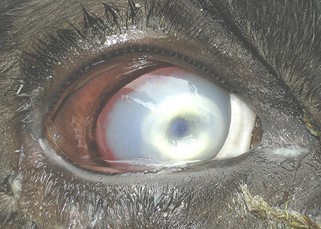
Two antibiotics, Tetracycline and Tulathromycin (Draxxin) are labeled to treat pinkeye. Extra-label drug use (ELDU) of Florfenicol (Nuflor) and Ceftiofur (Excede) has been reported. Chlortetracycline pellets (CTC) have been used for calf IBK metaphylaxis and CTC is only available with a veterinary feed directive. All antibiotic use will require slaughter withdrawal times.
ELDU involving sub-conjunctival injections (often are sub- palpebral, placed under inner surface of the eye lid) using penicillin have antidotal evidence of effectiveness. Sub-conjunctival/sub-palpebral injections have caused violative residues at slaughter markets. Topical antibiotic ophthalmic ointments may be helpful (benzathine cloxacillin).
Moraxella bovoculi appears to be less sensitive to commonly used antibiotics. Often times a mixed infection of Moraxella bovis and M. bovoculi fails clinical treatment, and then when tested, a drug resistant M. bovoculi is isolated. Generally, clinical signs due to Moraxella respond to antibiotics when caught early. Cases that fail to respond are often due to Mycoplasma or IBR.
Viral IBR may cause conjunctivitis. The resulting corneal involvement is usually located along the outer edge of the eye, not in the center like that of IBK. Calves born with eye infection may be the result of periparturient infection with IBR (or BVD). IBR is not nearly as common as was once thought. Even with careful diagnostics, labs often fail to find IBR; however, if you are having tough cases, test for it. Boost herd IBR immunity when you suspect IBR; but do not vaccinate with modified live IBR vaccines (MLV) during an IBK outbreak. IBK infected cattle are immune stressed and could develop IBR from MLV use in this instance.
Recovery from IBK is not immediate. Damage to the cornea and conjunctiva may continue after all bacteria are dead. It takes time for the eye to heal. If the cornea is scarred badly enough, it may never completely clear. Blindness or reduced eyesight in the affected eye may occur.
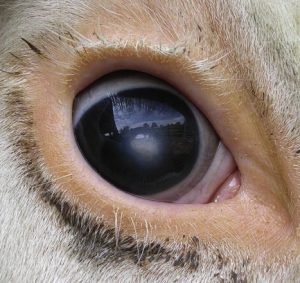
Pinkeye Vaccines
Five pharmaceutical companies currently produce commercial pinkeye vaccines for M. bovis; three have conditionally licensed commercial vaccines for M. bovoculi. Studies have shown that vaccination with M. bovis does not protect against M. bovoculi, and vaccination with M. bovoculi does not protect against M. bovis. Herds vaccinated with M. bovoculi vaccine have broken with IBK due to M. bovis. A prevention program with vaccines that target both M. bovis and M. bovoculi involves vaccinating with each product separately on the same day.
Since different strains of Moraxella are found in different vaccines, some vaccines may be more effective in a particular herd than another. Follow label directions! Some products recommend vaccine not be given to calves earlier than 2, 3 or 5 months of age. Some require a booster the first year the vaccine is given, others do not. Dosage itself varies between products. Some are available in combo with blackleg.
All IBK vaccines must be given 3-6 weeks ahead of the traditional summer IBK season as it takes time to develop protective immunity. Work with your veterinarian to determine how often to booster vaccines when dealing with winter pinkeye.
Current whole cell Moraxella bacterins have potential endotoxin concerns, and produce systemic IgG, which may not provide enough local eye immunity. Only piliated strains of Moraxella bovis have been proven to produce IBK in cattle and these appendages have antigenic and immunogenic properties. Moraxella bovis also produces a toxin and a hemolysin. Vaccines created from these antigenic components might create better immunity with fewer side effects (Prieto et al).
On-farm IBK pathogens can vary from year to year and therefore, treatments and vaccines used prior may fail. Find out what you are dealing with when your herd’s incidence of IBK is too high or response to treatment is poor. Culturing and antibiotic sensitivity testing takes the guess work out of treatment and helps to make sure treatments makes sense. Knowing which organism is involved allows evaluation of vaccine choices.
Those Pesky Face Flies!
Face flies have economic and health impacts to cattle. Twelve to fourteen flies per face decreases grazing time one hour per day. 20 – 200 per face is considered a heavy population and causes a lot of annoyance as cows cluster under shade. Mechanical transmission of diseases and active fly feeding causes further damage to eye tissue. Normal eye and nasal secretions attract face flies that feed on secretions. Face flies are not blood feeders like horn flies.
When talking about flies spreading IBK, our focus is on Musca autumnalis. The Musca fly family includes houseflies and stable flies; but neither swarm on faces like face flies do. Darker than a house fly, the adult face fly is 3/8 inch long. It’s a summer fly, feeding on secretions near the muzzle and eyes during bright sunny days. Face flies are strong fliers that can travel several miles. Face flies do not enter darkened barns or stables during the summer months. In the fall, however, they enter buildings and overwinter indoors in a state of hibernation.
Face flies are more active during hotter days, awake and feeding in bright warm sunlight, resting and not feeding during the night. Removal of decomposing feed, manure, bedding to reduce house and stable fly populations does not help for face flies as eggs are laid in freshly deposited manure (less than 15 min old). Control of face flies is achieved by regular application of insecticides to animals’ face and fly breeding sites (fresh manure).
Feeding fly larvicide may kill emerging face fly larvae in freshly deposited manure. Tetrachlorvinphos (RabonÒ) is an oral feed-through product and is labeled for face flies. To be an effective oral larvicide, it must be dosed to the weights of the animals, be consistently consumed every day, and fed throughout the entire fly season. Remember face flies are summer flies, so think about adding larvicidal products to feed beginning in July, perhaps when grass is less lush, and cattle are more likely to consume supplemental feed.
Using organophosphate or permethrin in sprays can be helpful to repel face flies. When using dust bags or oilers, make sure to hang them low enough so cattle can lift and rub them with their head. Place them where cattle are forced to use them, above the waterer, cross- over lanes, doorways or hung along the feeder wagon or bale feeder.
Insecticidal ear tags are labeled primarily for horn flies, some have face fly indications. Use as label directs. Adults usually need one in each ear; the calf usually needs one tag. Tag the calf too, as the calf will receive the flies repelled from the cow’s tags, and the calf is more susceptible to IBK.
Insecticide resistance develops, so switch tag ingredients between seasons. Check the label’s duration of activity and wait to apply tags so active ingredient is present when you need it. Face flies are a summer fly, especially active during the hotter days of July and August. Timely remove tags. Leaving them in leads to sub-therapeutic dosing which creates resistance.
Some pour-on parasiticides are labeled for horn flies. Horn flies are active blood feeders, obtaining the therapeutic ingredient from poured cattle. No pour-on products are specifically labeled for face flies. Some are labeled for stable and house flies which are in the same fly family as face flies, but passage of the ingredient into fresh manure has not been proven to be an effective face fly larvicide.
According to “Face Fly Biology and Management”, from the West Virginia Extension Service, face flies are attacked by parasitic nematodes, and immature stages of both horn flies and face flies are attacked by predaceous mites, predaceous beetles, and parasitoids.
Manure competitors such as dung beetles also limit fly populations by removing and burying cattle dung before immature flies can complete their development. Adult flies are attacked by predaceous yellow dung flies, and face flies are occasionally attacked by pathogenic fungi.
In spite of the diversity and importance of natural enemies of face flies and horn flies, methods are not known for exploiting these biological control agents in pest management programs. Parasitoid releases for house fly and stable fly control are not effective against pasture face flies.
Face and horn flies can travel for miles, so control is difficult when your neighbor’s flies are not being controlled. You may have more problems with flies when your neighbor is using repellant methods and you are not.
References
Special Thanks to Victor S. Cortese, D.V.M., Ph.D., Dipl ABVP (dairy), Director Cattle-Equine Immunology and Biologics, Zoetis Inc.
- Addison, Bruce Research Shows New Emerging Pinkeye Strain, retrieved April 29, 2014 http://progressivecattle.com/ component/content/article/120-herd
- Alexander, Dominic. Infectious Bovine keratoconjunctivitis: A Review of Cases in Clinical Practice. Vet Clin Food Animal 26 (2010) 487-503
- Angelos JA. Moraxella bovoculi and infectious bovine keratoconjunctivitis: cause or coincidence? Vet Clin Food Animal (2010) 73
- -78
- Boxler, Dave. UNL Extension Educator Reducing Fly Numbers on Pastured Cattle Univ of Nebraska-Lincoln, retrieved Jun 9, 2014 http://beef.unl.edu/ cattleproduction/controllingflies
- Cornell University, Dept of Entomology, retrieved Jun 9, 2014 http://vet.entomology.cals.cornell.edu/arthropod- identification/horse-recommendations/face-flies
- Connor, A.M. et al. Descriptive Epidemiology of Moraxella bovis, Moraxella bovoculi and Moraxella ovis in Beef Calves With Naturally Occurring infectious Bovine Keratoconjunctivitis (Pinkeye) Veterinary Microbiology 155 (2012) 374-380
- Dewall, Grant. Infectious Bovine Keratoconjunctivitis (IBK or Pinkeye) in Cattle ISU Extension Beef Veterinarian July 2010
- Foreyt, William J. Veterinary Parasitology Reference Manual 5th Edition, 2001 Iowa State University Press Blackwell Publishing Professional pages 100-101
- Funk, L et al. A Randomized and Blinded Field Trial to Assess the Efficacy of an Autogenous Vaccine to Prevent Naturally Occur- ring Infectious Bovine Kerato- conjunctivis (IBK) Vaccine 2009 ; 27: 4585-4590
- Hilton, Mark H. 5 Fly-Control Steps Beef magazine.com May 2014
- Huston, DVM, Carla. Pinkeye in Cattle. Mississippi State University Extension Service
- Hopkins, Fred et al, Pinkeye in Beef Cattle, Info Series AS-307 University of Tennessee Extension
- Prieto, Claudia I. et al. Vaccine Against Infectious Bovine Keratoconjunctivitis: A New Approach to Optimize the Production of Highly Piliated Moraxella bovis cells. Vaccine 26 (2008) 6542-6549
- Powell, Peggy K. Ph.D. Face Fly Biology and Management, West Virginia Extension service. Retrieved June 9, 2014 http:// www.caf.wvu.edu/~forage/facefly_mgmt.htm
Download Article

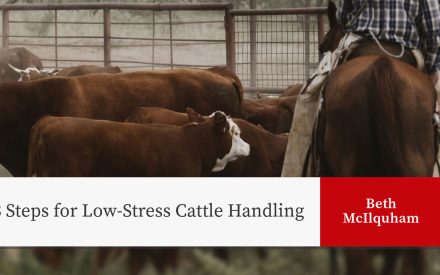 3 Steps for Low-Stress Cattle Handling
3 Steps for Low-Stress Cattle Handling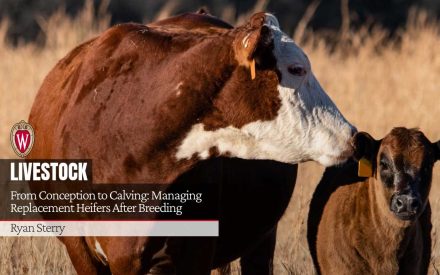 From Conception to Calving: Managing Replacement Heifers After Breeding
From Conception to Calving: Managing Replacement Heifers After Breeding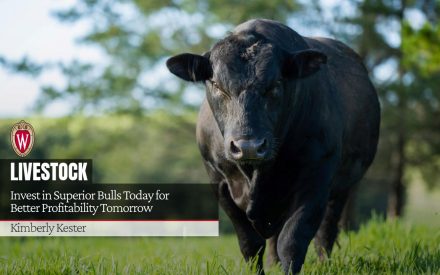 Invest in Superior Bulls Today for Better Profitability Tomorrow
Invest in Superior Bulls Today for Better Profitability Tomorrow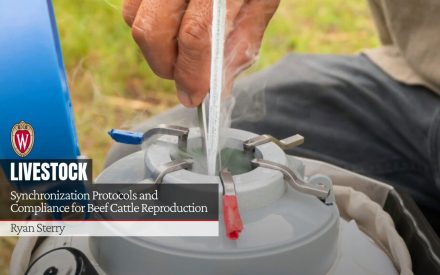 Synchronization Protocols and Compliance for Beef Cattle Reproduction
Synchronization Protocols and Compliance for Beef Cattle Reproduction


